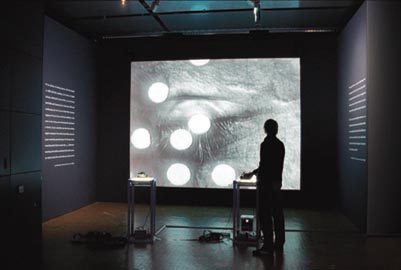
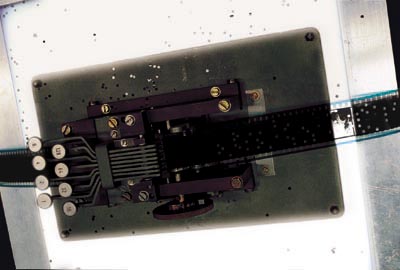
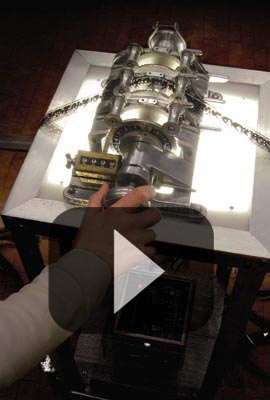
z2 [zuse strip]
(2002)
unwound 35mm film (approx. 250m), hole punch device, 2 cpu’s , digital
converter, 32 interactively controlled animation sequences, 12lines of Lev Manovich (quote 1) and 9 lines of John
Chadwick (quote 2), video projector, sound.
This work is a correspondence between two information fragments coming from
different origins and meeting by accident. Cinema is transformed into a three-dimensional
landscape utilizing data based an archaeological misinterpretation.
Z2 [zuse strip] is named after Konrad Zuse's second model, made in a series
of the first digital computers. It used discarded 35mm movie film from the
German UFA as a medium to read and write eight-bit binary code data with a hole-punch system. Lev Manovich wrote poetically about this encounter, declaring
Zuse's punch hole film to be the birth of Digital Cinema in which the "iconic
code" (film image) is overwritten by binary code (digital data).1
left wall:
“Starting in 1936, and continuing into the Second World War, German engineer Konrad Zuse
had been building a computer in the living room of his parents' apartment in Berlin. Zuse's
machine was the first working digital computer. One of his innovations was program control by punched
tape. For the tape Zuse used discarded 35mm movie film. [...] Whatever meaning and emotion contained
in this movie scene are wiped out by this new function as data carrier.
“Cinema
by Numbers” Lev Manovich 1999
right wall:
"There are obvious reselmblances between an unreadable script and a secret
code. Similar methods can be employed to break both. But the differences must not be overlooked.
The code is deliberately designed to baffle the investigator. The script is only puzzeling by accident."
"The Decipherment of Linear B" John Chadwick 1956
A
second reading of this film strip was inspired by the work of John Chadwick, one of the two linguists who deciphered a script from Bronze-Age Greece known
as "Linear B." (Text below) Chadwick wrote about the nature of code-breaking,
the differences and similarities between secret codes and ancient script. While
the former deliberately intends to baffle its reader, the latter creates its
puzzling effects by accident.
Were one to scrutinize Zuse's film strip with the eye of an archeologist,
one might assume a necessary relation between the image of the film and Zuse's
punch-holes. The holes in the Zuse strip might represent a sound score, or
a plan detailing the images' presentation. Similar assumptions resulted from the
reading of unintentional scratches in the hieroglyphics of the Rosetta Stone,
or on the broken clay plates that Chadwick helped decipher.
The impact of the hole punch is imprinted directly into the film, changing
its surface. I have exaggerated these impacts using digital animations, turning
these holes into craters of varying sizes and depths. The crater landscape
also affects the topography of the surrounding area.
A virtual camera flies over this landscape of the image, into and out of the
craters.
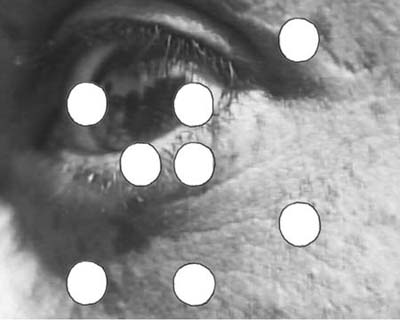
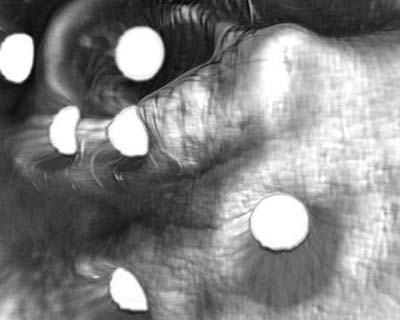
This movement
is accompanied by a soundtrack created from the same information. The four
double rows of eight-bit holes become the score of a musical clock. For each
frame a dissonant chord is audible, its individual tones changing pitch according to the position of the flying camera, to its distance from
the particular holes.
Z2 [zuse strip] addresses our ability to preserve cultural artifacts. Obsolescence
is the repressed remains of innovation, and since the information of the past
is encoded in defunct systems, how will it be possible to preserve the past?
Translation (from the Latin "translatum," meaning to bear across)
is a journey as opposed to instantaneous transmission, and these journeys
of re-encoding, transcribing and compressing re-impose the codes of the present
on their info-passengers.
1 Lev Manovich, Cinema by Numbers. The ASCII Art of Vuk Cosic, 1999.
hardware:
The punch hole device is modeled after the exisiting replica of from the original Z3. Generous help provided by Konrad Zuse’s son,
Dr. Horst Zuse and the Konrad- Zuse-Zentrum for Information Technology in Berlin.
software: customized video sampling software by Johnny DeKam (www.node.net)
For their valuable help and input my thank goes to Horst Zuse, Raúl Rojas, Lev Manovich and Simon Singh.
<<